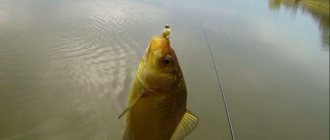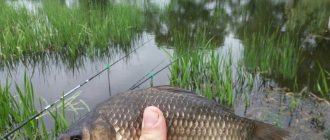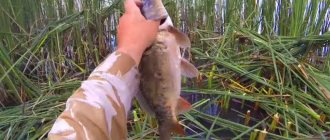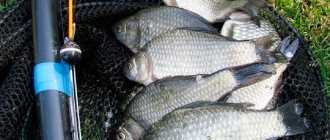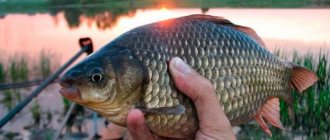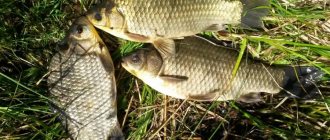Roach
is a schooling fish of small size, which is found in almost all rivers and can very often be found on the hooks of fishermen. In order to intensify fishing and make it effective, it is necessary to detain the roach at the biting point, and for this it is best to use bait.
Store-bought bait versus homemade mixture
To prepare or select bait for roach, you should know several important factors.
- Groundbait color.
Roaches are peaceful fish and need to camouflage themselves effectively to protect themselves from predators. When the bottom of the reservoir is dark, the back of the roach has the same color. In this case, a light spot of bait can disguise the roach. - Fish should not be overfed.
To minimize the amount of bait, you need to add raw clay to the mixture. Its amount can reach up to 30-50% of the total volume of bait. - The smaller the size of the roach specimens
, the less components of animal origin should be in the finished mixture. - If you fish in the current
, it is advisable to use binding ingredients. These may be components of PV1, which includes brown sugar.
If we focus on industrial baits, we should pay attention to their versatility, which makes it possible to use them for various fishing conditions. Sometimes they are modified, after which the mixture can be molded and thrown into balls.
Homemade bait mixtures are best used in conditions where the taste preferences of fish have been studied.
Depending on the consistency and ingredients included in the bait, you can attract either small or large roach. For smaller specimens, it is necessary to create a voluminous feeding spot in the water column, and for larger specimens, denser bait is used, which creates a feeding spot at the bottom of the reservoir.
Where to look for roach in the spring for fishing with a fishing rod
Roaches love creeks and river bays, where, with the first arrival of warmth, a food supply in the form of larvae, insects and other living organisms is actively formed. Very promising places for catching roach in early spring are the mouths of medium and small rivers. If you go fishing like this, you can get great pleasure from float fishing for roach. At this time, it comes close to the shore and you can even catch it with a fly rod.
At the beginning of spring, roaches often stay in places where melt water flows into the river. Larvae accumulate here in large numbers and are washed away by the river from the coastal zone.
Usually, during the pre-spawning period, roaches gather in schools and head to tributaries or to more secluded places on the river. When searching for promising spots for fishing for roach using a float rod, the main emphasis should be on places with coastal and aquatic vegetation. Large roaches love to feed on amphipods and various small insects, which are found in large quantities at these points. The bottom here should be sandy, rocky or clayey.
If you come to an unfamiliar body of water, be sure to look for areas with weak currents located along the waterways. A lot of roach accumulate near spits, in bays where there are reeds nearby. When fishing in such places, the main bait in spring is caddisfly.
When the water level increases noticeably in spring, large roaches often gather in the area of old bridges, where there is often a good food supply for roaches. It is convenient to fish there with a fishing rod and wire.
A very promising area for fishing for roach are coastal dumps or the first edge. It is best to fish in such areas with a Bolognese fishing rod. Fishing will be especially promising in the second half of spring, when the water level drops slightly.
In spring, roach is best caught in areas with depths of 2 to 2.5 meters. You should remember this well and always try to find areas with exactly this depth. It is best to find places where the current weakens somewhat. Here you can do wiring, and the food will linger at the bottom, collecting a large amount of roach.
Components of baits
The bait ingredients are selected depending on the fishing conditions. If fishing is carried out in reservoirs that are actively visited by fishermen, then it is better to introduce feed bloodworms and soil taken from the shore of the reservoir into the bait. Good results are obtained from mixtures based on sweet cookies soaked in water.
If fishing conditions require fast currents, then you can use standard types of bait, using breadcrumbs or grain bran. They are easily washed away in a stream of water and form a cloudy trail of bait, which certainly attracts fish. An equally important ingredient is the flavoring agent, which must be carefully manipulated to achieve a soft and attractive aroma. To increase the viscosity of the mixture, you can add soil taken near a pond to its composition, which will not repel roaches.
Bait
Bait in the spring, of course, should be animal, the roach is recovering from the winter period, and it needs to get itself in order as soon as possible, so earthworms, dung worms, maggots would be preferable as bait; if the roach is very weak, perhaps bloodworms will help stir her up. It is necessary to be especially sensitive in determining not only the type of nozzle, but also its size. The colder the water, the more delicate, in my opinion, the bait should be, therefore, the hooks should be smaller and thinner, in such conditions I try not to experiment with a combination of baits - maggot with bloodworms, maggot with a worm - as a rule, this does not help , but on the contrary, it repels even large roaches. If the water has warmed up quite well, you can experiment with both the type and size of the nozzle.
If there is some kind of constant bite, you can gradually try to increase the size of the bait - a larger worm, if you are fishing with maggots or bloodworms, then you can gradually add their quantity to the hook and monitor the changes, you can also combine baits. Of course, it is better to catch roach during this period in favorable weather conditions, on sunny days, preferably without wind; we must not forget about pressure.
Making bait for roach with your own hands
Even a novice fisherman can prepare bait for catching roach on his own; he just needs to stock up on the appropriate ingredients, choose the right recipe and follow the advice.
Recipe No. 1
- Breadcrumbs – 0.3 kg.
- Steamed rye – 0.3 kg.
- Oatmeal – 0.2 kg.
- Ground rolled oats – 0.1 kg.
- Grated garlic – 0.5 tablespoons.
- Roasted hemp seed, crushed – 50g.
- Filamentous algae – 50g.
- Small maggots - 2-3 matchboxes.
Recipe No. 2
- Ground flaxseed cake – 0.2 kg.
- Oatmeal – 0.2 kg.
- Sifted clay – 0.1 kg.
- Fried bran – 0.3 kg.
- Lentils – 20g.
- Coriander – one pinch.
- Young nettle – 50g.
Recipe No. 3
- Ground biscuit – 0.3 kg.
- Breadcrumbs – 0.1 kg.
- Dry clay, crushed – 0.1 kg.
- Cumin – one pinch.
- 2-3 matchboxes of small bloodworms and maggots.
- Bran – 0.1 kg.
Recipe No. 4
- Fried bran – 0.2 kg.
- Steamed wheat – 0.3 kg.
- Breadcrumbs – 0.3 kg.
- Ground pumpkin seeds – 0.2 kg.
- Tubifex - 0.2 kg.
- 2-3 pinches of thyme.
- 2-3 drops of formic acid.
Bait for feeder fishing
For feeder fishing, you can use a widely used method, which involves mixing store-bought bait with homemade bait. This option gives very good results, and such bait will cost a little less. The only challenge is to achieve the appropriate consistency. Properly prepared bait with the right consistency will always work and fishing will be productive.
The following ingredients can be added to feeder baits:
- Breadcrumbs.
- Corn flour and cereals.
- Biscuit.
- Elements of animal origin.
- Nuts.
- Salt and sugar.
- Flavors.
- Clay and sand.
Recipe for passive roach
Ingredients:
- rye bran – 3 parts;
- crushed rye crackers - 2 parts;
- wheat bran – 1 part;
- crushed hemp seeds - 1 part;
- corn flour – 1 part;
- bloodworm or caddisfly - 0.5 parts;
- pigeon droppings – 0.5 parts;
- salt – 0.2 parts;
- coriander – 2 pinches.
Do-it-yourself bait for roach in early spring from these ingredients copes well with its role in clear water during periods of low fish activity.
The recipes given are not mandatory, they are intended to show what you can use to prepare a bait mixture and what to pay attention to.
Flavorings for bait
To make fishing more effective, you can add various flavors to bait mixtures. Vanilla is very popular among fishermen, but not culinary, but branded, which can be added to the bait mixture at the rate of 100g per 1kg. Vanillin has a bitter taste, so adding it to ready-made recipes is not recommended.
Coriander also attracts roaches, due to the fact that when its particles fall into the water they float and certainly attract fish.
Many fishermen prefer anise, which has a pleasant aroma and increases the appetite of roaches.
Ready-made purchased mixtures, in addition to the above components, may also contain the following aromatic additives:
- Almond.
- Chocolate.
- Hemp.
- Caramel, etc.
Flavorings should be handled carefully so as not to spoil the bait. The bait should have a soft, alluring aroma, but not a heavy aromatic smell, which may not attract, but rather scare away the fish. Therefore, flavoring additives are measured in drops, but not in grams.
Ready-made mixtures are quite effective, but they are also quite expensive, so they are not available to all fishermen, and as they say, why pay extra money when you can prepare the bait yourself, and the result will be the same. An experienced fisherman will be able to fish with simple mixtures, but for an inexperienced fisherman, even store-bought ones will not produce results.
Methods and gear for spring roach fishing
Spring bait for roach is not the only thing that is useful when fishing. The float fishing rod or bottom fishing rod has become especially popular lately. These types of fishing rods are light and elegant, making fishing much easier. Tackle also plays a major role. The thickness of the fishing line can reach 0.16 mm, and the diameter of the float is 0.12 mm. Hook parameters directly depend on the choice of bait size. As for the float, it should be moderately heavy so that the angler can feel even the slightest approach of the fish, since roach behave cautiously in the spring. If an angler prefers feeder fishing for roach, then you cannot do without a special fishing line that should not stretch. Under no circumstances should you skimp on it, since the quality of the fishing line will determine the catch. Baiting for roach in the spring should be light, since the fish approach quite close to the shore. The feeder can be metal, and its shape depends on the state of the water, for example, in stagnant water you can catch roach using a feeder of any shape and made of any material.


